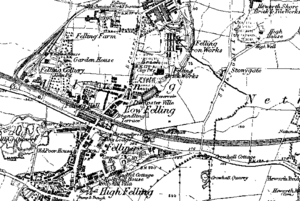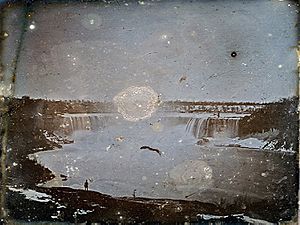Hugh Lee Pattinson facts for kids
Quick facts for kids
Hugh Lee Pattinson
|
|
|---|---|
 |
|
| Born | 25 December 1796 |
| Died | 11 November 1858 (aged 61) |
| Resting place | Washington, County Durham |
| Nationality | English |
| Alma mater | Self-taught |
| Known for | Silver refining process, daguerreotypes |
| Spouse(s) | Phoebe Walton |
| Scientific career | |
| Fields | Metallurgy, Industrial chemistry |
Hugh Lee Pattinson (born December 25, 1796 – died November 11, 1858) was an English chemist who worked in factories. He was also a smart businessman. He worked with famous people like Isaac Lowthian Bell, who made iron, and Robert Stirling Newall, who made cables.
Pattinson was well-known for his 1833 invention. It was called "An improved method for separating silver from lead." This special process is still named after him today. He is also remembered for his early photographs, called daguerreotypes, from 1840. One of these is the oldest known photo of Niagara Falls.
Contents
About Hugh Lee Pattinson
Hugh Lee Pattinson grew up in Alston, Cumberland. His father, Thomas Pattinson, owned a shop. His family were Quakers. Hugh went to local private schools.
He loved science from a young age. When he was 17, he did experiments with electricity. He also studied how metals worked. He started by helping his father in the shop. Around 1825, he worked for a soap maker in Newcastle-upon-Tyne.
In 1825, he became an assay master in Alston. This meant he tested how pure gold or silver coins were. He kept experimenting with metals. In 1829, he found the basic idea for his method to separate silver from lead. But he didn't have enough money to develop it further.
In 1831, he became a manager at a lead factory. This job paid him more money. It allowed him to continue his experiments. He worked until his silver refining process was ready to use. In 1834, he left that job. He started a new chemical factory with John Lee and George Burnett. This factory was in Felling, near Gateshead. About 300 people worked there.
Pattinson's Silver Process
Pattinson got a patent for his process in 1833. This process made lead that contained silver richer in silver. It worked because when molten (melted) lead with silver cools, the lead hardens first. This leaves the liquid part with more silver.
Pattinson's equipment was simple. It was a row of about 8 or 9 iron pots. These pots were heated from below. Lead with a small amount of silver was put into the middle pot and melted. Then, it was allowed to cool down. As the lead hardened, it was scooped out. This lead was moved to the next pot in one direction. The remaining liquid metal, which now had more silver, was moved to the next pot in the other direction.
This process was repeated from pot to pot. The lead gathered in a pot at one end. The metal with more silver gathered in a pot at the other end. This process could make the silver much richer. But it couldn't get all the silver out. So, another process called "cupellation" was used to finish the job.
Pattinson earned £16,000 from his patented process. Before his method, factories needed at least 8 ounces of silver per ton of lead to make money. Pattinson's process worked even with just 2 to 3 ounces of silver per ton. This made it much more efficient.
Early Photographs (Daguerreotypes)
Around 1840, Pattinson traveled to Canada. He hoped to start a mining business there. He stopped at Niagara Falls and took the earliest known photograph of the falls. This photo is a daguerreotype, a very early type of photograph. It is still kept at Newcastle University today.
For a long time, people thought a small figure in the photo was added later. But the figure is clearly in the original photograph. Because these early photos needed a very long exposure (about ten minutes), the figure is thought to be Pattinson himself. The picture is a mirror image and was taken from the Canadian side.
Pattinson took other photos of the Horseshoe Falls. He also took pictures in Rome and Paris. These photos were later used to create engravings for a book called Excursions Daguerriennes. Pattinson's image is not only the first known photo of Niagara Falls. It is also the earliest surviving photograph of any part of Canada. Canada became a nation 27 years later.
Other Inventions
In 1841, Pattinson patented two more chemical processes. One was for making lead carbonate. The other was for making "magnesia alba," a white magnesium oxide. In 1849, he patented a process for a new white lead pigment. This was called lead oxychloride.
His lead oxychloride process became a successful business in 1850. Pattinson and his business partners started a chemical company. His partners were his sons-in-law, Isaac Lowthian Bell and Robert Benson Bowman. Their company was in Washington, County Durham.
Honors and Achievements
In 1838, Pattinson became a vice-president. This was for the chemical section of the British Association. He was also a member of the Geological Society. And he was a member of the Royal Astronomical Society.
Pattinson was made a Fellow of the Royal Society (FRS) on June 3, 1852. This was a high honor for his work with metals.
Family Life
Hugh Lee Pattinson married Phoebe Walton on December 25, 1815. His wife's family would not accept him being a "Quaker". So, he was baptized into the Church of England just before their wedding. He took his mother's last name, Lee, at the baptism.
Pattinson had three daughters. They married important men. One married Isaac Lowthian Bell, the ironmaker. Another married Robert Benson Bowman, a bookseller. The third married Robert Stirling Newall, who made cables. These three men, who were brothers-in-law, worked with Pattinson in different businesses. They were also all members of local nature clubs.
Hugh Lee Pattinson passed away on November 11, 1858. He was buried in the churchyard in Washington, County Durham. He was survived by his son, also named Hugh Lee, and his three daughters.



